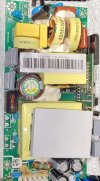So I ran a stress test and did my off and on test and the power supply held up.. So I thought I would post my final thoughts for others that might take on the task of repairing a POE+ Switch. Reason i wanted to repair this one is that it is not only a POE+ it is a Giga POE+ switch and works well with the few Giga POE cameras that I own from
Uniview and Alibi..
When repairing a switching power supply like this PoE+ 8-port unit, sometimes you're forced to substitute a different MOSFET if the original part is hard to get, like the JCS13N50FT. In this case, I used TK18A50D parts from Mouser, and the repair held up well through a proper burn-in test. That said, there are a few things to keep in mind if you're using a part that's not an exact match.
The first thing to consider is the gate charge, or Qg. A part with a significantly higher gate charge can switch more slowly, which not only reduces efficiency but can also lead to excess heat and potential overstress on the gate driver circuit. It’s something that’s easy to overlook, but in tightly tuned flyback supplies, timing matters more than you might think.
Another spec that can trip people up is RDS(on), or the drain-source on-resistance. If the part you choose has a much higher value than the original, it’s going to run hotter during operation, especially under load. Fortunately, the TK18A50D actually has a lower RDS(on) than the original JCS13N50FT, so in this case it’s actually an upgrade in terms of conduction loss.
Switching speed,, that is, how fast the MOSFET can turn on and off is also a big factor in power supply behavior. If the replacement part is significantly slower, you can end up with longer transition times, more heat, and maybe even oscillation or noise in the supply. It’s worth checking the rise and fall times in the datasheet to make sure you’re in the same ballpark.
The safe operating area, or SOA, is another spec that doesn’t always get the attention it deserves. If the replacement part has a weaker SOA than the original, it might not survive the voltage and current spikes that happen during normal operation. especially at startup or when the load suddenly changes. The TK18A50D has a good SOA for this kind of application, but it’s still worth confirming.
And finally, always make sure the voltage rating matches. In this case, both parts are 500V rated, so there’s no concern about breakdown from high-voltage flyback spikes.
The key thing is not to just match the Vds and current rating and call it a day. It’s important to consider how the part will behave in the real-world circuit, particularly how it switches, how much heat it generates, and how much stress it can take. After swapping the parts, a burn-in test is crucial. That gives you a solid check that the replacement is handling everything the power supply throws at it under actual load.
So to anyone else making a repair like this, don’t just drop in a “close enough” part. Compare gate charge, RDS(on), switching behavior, and SOA, and make sure your driver circuit is still up to the task. If all those check out, you’ve got a solid chance of a long-lasting repair.
And one last thing, be safe. These supplies operate at dangerous voltages, and the risks are real. If you're not completely confident working around high voltage circuitry, it's best to step back and find someone qualified to handle the repair. When in doubt source it out.


